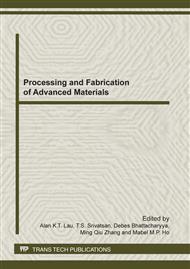p.55
p.59
p.63
p.67
p.71
p.75
p.79
p.81
p.86
Effect of Heat Treatment on Chemical Structure of a Bio-Filler from Vetiver Grass
Abstract:
In this work, the effect of heat treatment on chemical and crystalline structure of vetiver powder was studied. The vetiver powder was heat treated at 170°C, the temperature below thermal decomposition of hemicellulose, for 2-6 hours. The chemical structure, crystalline structure, and thermal decomposition of untreated and heat-treated vetiver were examined via FTIR spectrometer X-ray diffractometer, and thermogravimetric analyzer, respectively. In addition, the particle size and size distribution, fiber surface, and specific surface area were investigated by particle size analyzer, scanning electron microscope, and BET surface analyzer, repectively. It was founded that some waxes, lignin, and hemicellulose were removed by the thermal treatment. This resulted in smaller particle size of heat-treated vetivers. In addition, moisture content was minimized from 7 to 4 wt% by the treatment. However, removal of those compositions did not influence crystal structure of cellulose and surface functional groups of heat-treated vetiver.
Info:
Periodical:
Pages:
71-74
Citation:
Online since:
November 2011
Keywords:
Price:
Сopyright:
© 2012 Trans Tech Publications Ltd. All Rights Reserved
Share:
Citation:


